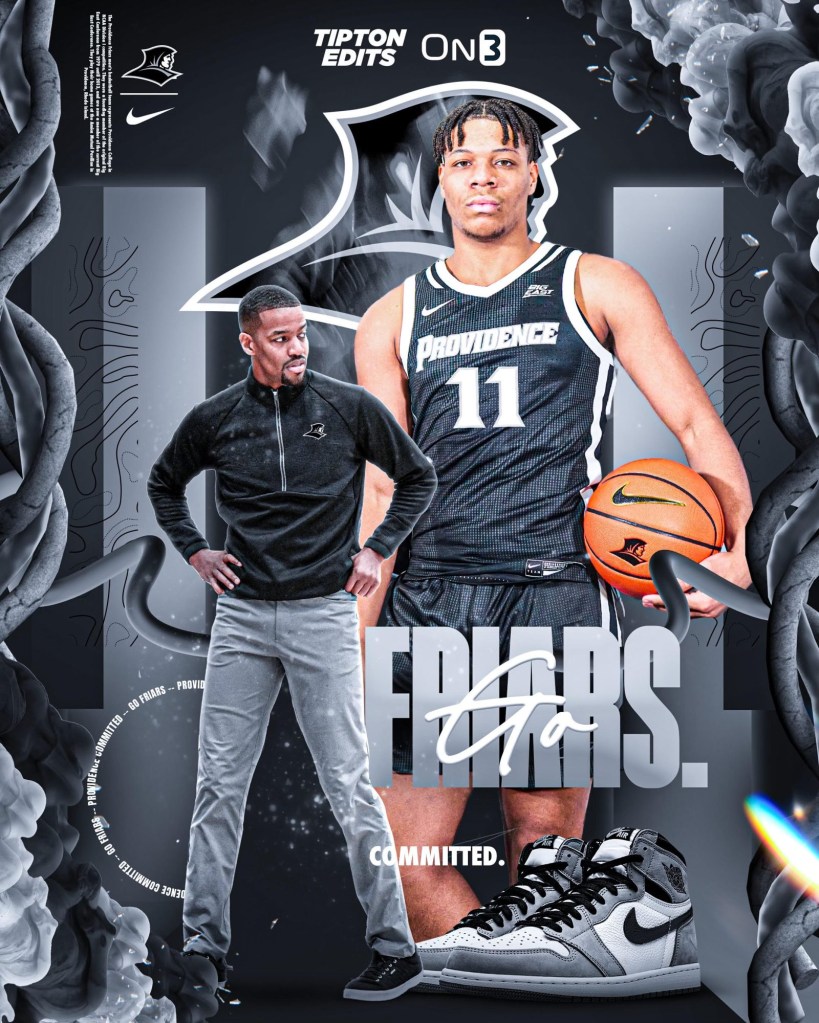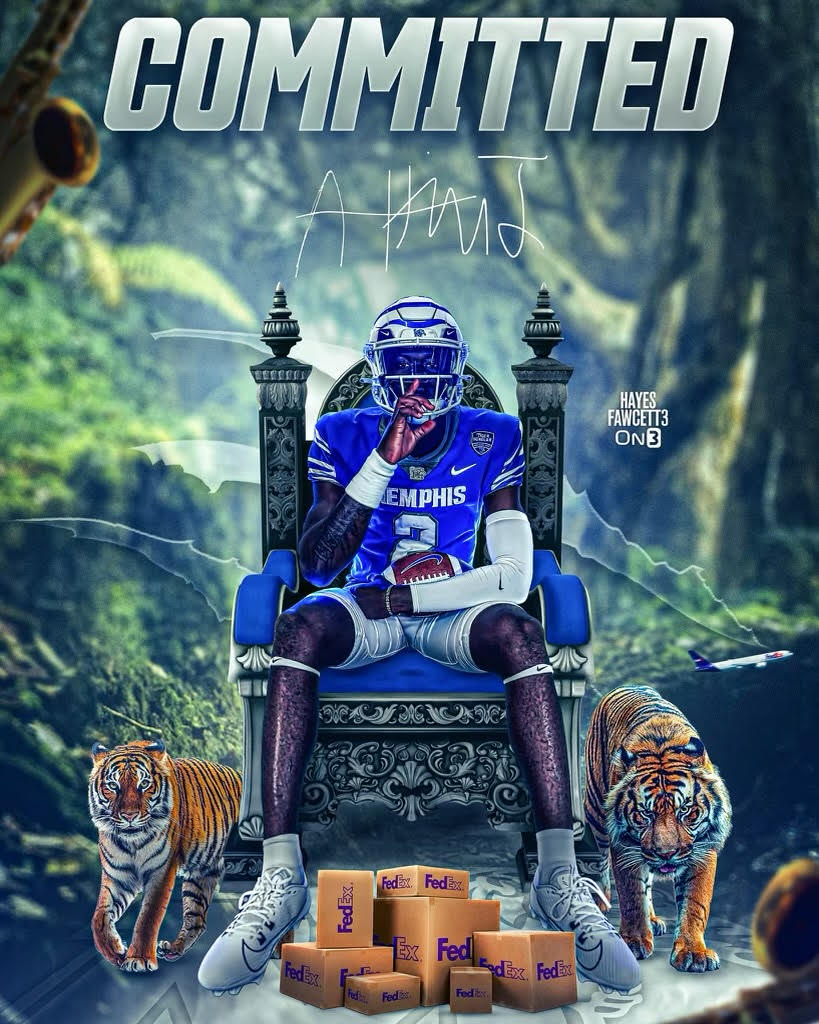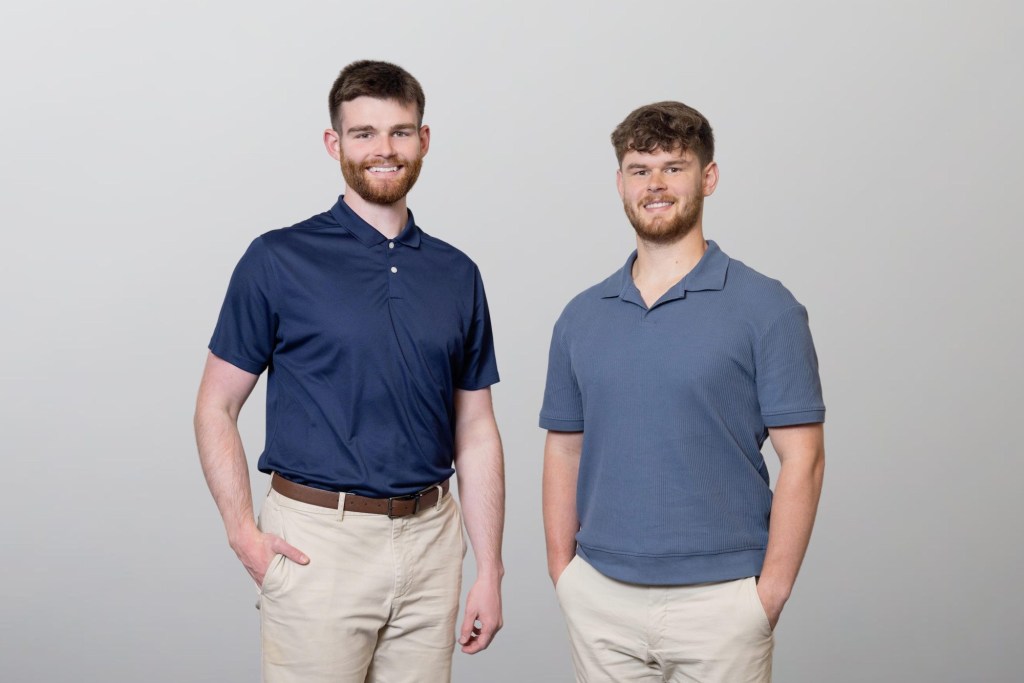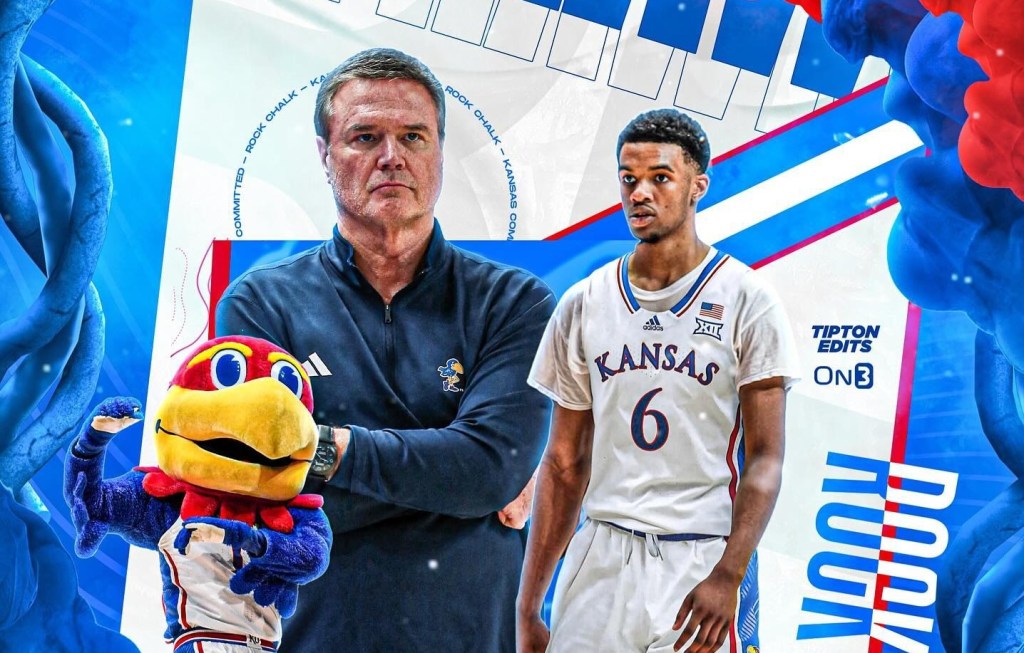Near the end of April, sophomore shooting guard Rylan Griffen texted Joe Tipton with big news: he was transferring from Alabama to Kansas.
Tipton, an On3 national basketball reporter, perked up at the notification. He’d been following Griffen’s journey since high school and now had a scoop in the heart of the transfer portal season. But this wasn’t free information. In exchange, Griffen had requested a “Tipton Edit,” the 25-year-old reporter’s social media graphic service, which would announce Griffen’s new team on Instagram by superimposing a Jayhawks uniform onto the 6′ 6″ star.
The pair quickly began discussing the particulars, deciding what flourishes to add to the graphic and when to collaborate on the post. A week later, Tipton published the final product: a collage featuring Griffen in a Kansas jersey beside the team’s coach Bill Self and the Jayhawk mascot, all surrounded by an abstracted red, white, and blue border.
“I knew that he had a big brand so it was a good deal,” Griffen tells Front Office Sports. “He made the design look cooler than just a plain picture of the jersey.”
That brief transaction is one of hundreds that Tipton juggles throughout the year, working long hours to build graphics for every major transfer announcement and recruiting commitment across the basketball landscape. It’s painstaking work—especially during busy recruiting seasons—which requires loads of screen time and a regimented daily calendar to ensure every photo request gets completed and treated with the same effort and amount of creativity. “While the portal is open, it’s absolute mayhem and madness,” Tipton tells FOS. “Every time my phone buzzes, I have to check it.”
Hayes Fawcett, Tipton’s 22-year-old colleague, can relate. He pulls the same duties on the football side for On3—Shannon Terry’s college sports and recruiting digital media company—providing countless high schoolers with flashy photo edits highlighting their gridiron commitments. Similar to Tipton, he is a slave to his phone, constantly communicating with players about college and transfer decisions before building out graphics that will legitimize and elevate their personal brands. “Joe and I definitely have similar personalities,” Fawcett says. “We’ve definitely helped each other grow throughout the years.”
Together, Tipton and Fawcett may be on their way to becoming the proverbial “Woj and Schefter” of the high school recruiting world: two Southern kids who’ve earned their designation as the premier designers and news breakers of their niche-but-growing graphic-making industry.
Since joining On3 at its start in 2021, the pair have only enhanced their reputations, scooping long-established college reporters and utilizing Terry’s resources and network of contacts.
“We are at a time where your ability to be authentic and your ability to break news is so critical right now, and there are so few people that are actually doing that in the media,” Terry tells FOS.
Yet as Tipton says, he and Fawcett both “kind of stumbled into it.”
Growing up in Gurley, Ala., Tipton initially liked the idea of a career in graphic design. He’d pursued his interest by making casual photo edits, slapping Nike logos and inspirational quotes onto generic images of five-star athletes and sharing them on his own account. At the time, most high school athletes announced their college recruiting decisions by posting screenshots on their notes apps. But he realized he could provide them something flashier. As more players turned to social media to announce their potential collegiate destinations, they began contacting the 17-year-old.

“They were like, ‘I’m down to five schools, can you put the logos around me?’” Tipton says. “Then it just kind of bloomed because everyone else followed suit and no one else was making graphics.”
Tipton started out obliging Junior College and Division II athletes. Then, in 2016, he opened ESPN’s Top 100 high school players list and began soliciting stars with his free services, leading to collaborations with former college stars turned NBA players—Harry Giles III, Josh Jackson, and Miles Bridges. Tipton didn’t have a blueprint for building relationships and hadn’t taken any high school graphic design classes beyond the tutorials he’d found online. But he knew his service was catching on. “The whole idea of an edit in the high school and college space was not around when Hayes and I started,” he says. “That’s why we were able to kind of grow and progress. We were on the front lines.”
Several hundred miles away, in Kinder, La., Fawcett’s graphic design journey was taking shape on Instagram. In 2014, as a middle schooler, he’d scrolled past a LeBron James photo edit and felt inspired to make his own. After experimenting with various design apps on his phone, he began gaining traction on his own social accounts. Soon, he branched out locally, offering his skills to several heavily recruited players on his town’s state-champion high school team. As a three-sport athlete himself, he relished the opportunity to make connections with older athletes.
“You grow up looking up to those players, and to be able to connect with them was huge for me at such a young age,” Fawcett says. “I just remember being so starstruck knowing that they’d be in the NFL in the near future.”
His service took off when Catholic High School running back Derrius Guice, an eventual LSU All-American and second-round NFL draft pick, began posting a variety of Fawcett’s promotional and showcase graphics. Not long after, other nationally ranked players started following Fawcett on Twitter and sliding into his DMs with their own requests. His profile grew overnight, forcing him to reconsider his hobby. “I really need to take a deep dive into this and see where it could go,” Fawcett remembers thinking.
Throughout the next couple years, as he developed into a high school quarterback, he scaled up his networking and photo editing, making graphics for the country’s top quarterback prospects, including Clemson’s Trevor Lawrence and Ole Miss’s Shea Patterson. Also on the list was Dwayne Haskins, who, in exchange, offered to watch his game film, provide him mechanical pointers, and answer any questions.
What does a “Tipton Edit” look like? Tipton himself is “at a loss for words” trying to describe it. “I wouldn’t even say they’re unique.”
True to his assessment, the majority of Tipton’s graphics have a basic feel and layout. They mostly feature a recruited athlete wearing his new team’s uniform and the logo of his committed school, splashed with his “Tipton Edit” watermark. Occasionally, he’ll get a little artistic, adding a mascot or more vibrant backdrop, depending on specific player requests or if he can find unique photos. Otherwise, he says, the goal is to pump them out cleanly and efficiently. “A lot of it is just reusing the same Photoshop file that I’ve been using for years,” he says. “The player doesn’t necessarily care what the edit looks like. They’re posting it for the Tipton Edit brand.”
Although he could have pursued graphic design into college, Tipton realized what he really wanted was a plausible way into the sports industry. His photo edits did just that, functioning as a vehicle for immersing himself into the recruiting world which, in turn, allowed more people to see his graphic work. “I kind of realized [with the edits] I might actually have a chance to break into the sports world,” he says. “My passion is the reporting side of it. The rush that you get from breaking a big story is second to none.”

Fawcett’s graphics have a little more flair. They’re vibrant, crowded, and even a bit gaudy. He admits they’ve evolved from his early phone-editing era, when he’d promote a Buckeye commitment with “Ohio State colors, the logo, anything that portrayed the school.” As he’s gotten more skilled as an editor, Fawcett’s concepts have gotten more creative, often taking into account a city’s landmarks and cultural signifiers. Consider a recent graphic in which four-star quarterback Antwann Hill Jr., announcing his commitment to Memphis, sits in a throne flanked by two Bengal tigers with a pile of FedEx boxes at his feet. “I just put all of my time, energy, and effort into grinding these graphics and trying to really go above and beyond for five-star players and big-time transfers,” Fawcett says.
Even with his early success, Fawcett contemplated pausing his edit business. At the end of high school, he had an opportunity to play quarterback at Lousiana’s Northwestern State University as a preferred walk-on, a time commitment that would have prevented him from keeping up with player requests. He also contemplated a job working on LSU’s recruiting staff, which would have meant deleting his social accounts and ending his graphic-making. The sacrifice was too great, so he took an academic scholarship at Northwestern State and kept his design dreams alive.
“I just ultimately decided it would be best for me and my future to go all in covering recruiting,” Fawcett says. “The more I thought about it, the more it was a no-brainer.”
When Shannon Terry launched On3, he was determined to make it a college sports destination. Throughout the previous three decades, he’d been on the forefront of building and flipping profitable sports media companies, creating Rivals.com, which he sold to Yahoo! in 2007, before handing over his next company, 24/7 Sports, to CBS in 2015. As he looked to build his third venture, he knew he needed news breakers with dedicated followings who could cut through social media’s growing static and biased algorithms.
“We wanted to build an authentic media company heavily around first-hand reporting,” Terry says. “That research led us to what Hayes and Joe were doing pretty quickly.”
The timing was perfect for Tipton, who had just graduated from the University of Alabama in Huntsville. While scrolling through Twitter one day, he realized Terry followed him, looked up his credentials, and quickly shot him a DM. “We got on a Zoom call later that week and then he offered me a job,” Tipton says. Determined to find Tipton’s football counterpart, Terry wasted no time reaching out to Fawcett, who was a bit more well-known online and was eager to land a job at the end of his freshman year.
The On3 brand has added polish to the pair’s resumes, adding more legitimacy (plus a strong, additional brand) to their news-breaking graphics. The transition has been largely seamless; Terry hasn’t attempted to change anything about their process. He’s allowed them to maintain their own private relationships with players and coaches, asserting that On3 isn’t privy to any of the information that Fawcett and Hayes collect throughout the recruiting and transfer seasons. “We’ve managed and maintained those boundaries, and we’ve developed trust with the athletes,” Terry says. “It’s an incredibly powerful tool for the brand in a lot of ways.”
As their stature grows, Tipton and Fawcett have established a strong, unique power in the recruiting ecosystem—becoming their own breaking-news desk.

When Fawcett was younger, he’d immediately send a finished graphic to players, letting them post it to their accounts so long as they tagged him on Twitter or Instagram. He wasn’t building his own brand so much as being helpful. “I didn’t even really understand the nature of breaking news,” he says. “They would post it and I would repost it.” Once he and Tipton became more established, however, that equation started to flip. The pair recognized the value in being scoop artists and making their accounts more than just art galleries, changing the dynamics of the transaction to work around their schedule and accounts.
“There’s oftentimes where a player will reach out and say, ‘Hey, I’m going to this ACC school and I want to announce tonight,’” Tipton says. “If I’m out with my fiancée or my family or I’ve had a long day, I’ll ask to wait until the morning. So we can kind of dictate when the news actually drops.”
Terry says this piece is far more important than the graphics itself. “It’s the relationships and the distribution, and the trust. That’s what they built.’”
Now full-time with On3, working remotely from their hometowns, both designers have extremely full plates—ones that they’re only filling more as they take on increased on-camera presence and more writing. In the past year—which has included signing contract extensions with On3—Fawcett and Tipton have also dedicated more time to covering the transfer portal and following NIL deals, keeping up with the ever-shifting collegiate sports landscape. Tipton would also like to eventually cover the coaching carousel.
For now, they’re both locked into a rhythm. On a typical summer day, Tipton maps out his weeks on a big white board inside his one-bedroom apartment, filling in different time slots with a marker (and then his phone) whenever a recruit settles on an announcement date. In between making graphics, he’ll parse On3’s proprietary high school database, updating the company’s list with scholarship offers and likely commitments. In the busier transfer portal seasons, he often wakes up to handfuls of players messaging him about when they want to announce their transfers, adding more importance to his daily prep.
“A lot of things in the portal happen quickly,” Tipton says. “You thought you had five commitments for the day on Sunday evening that you’re ready for, but when Monday hits, players come in and say, ‘Hey, I’m committing to Duke in 45 minutes.’”
“Some days I might not even have time to get up and go eat,” Fawcett adds. “That’s just how fast things are moving.”
Their improbable journey is not lost on Tipton—especially since at one point, he once considered selling “Tipton Edits” all together. A college sophomore, he messaged his buddies with concerns that his life was getting too busy to keep up with this increasingly thrilling but burdensome hobby. He had school work, a girlfriend, and a part-time job. But they convinced him to keep at it. “You might have something here,” they told him.
“I never would have thought it would amount to anything,” Tipton says. “Now I’ve got my dream job.”



